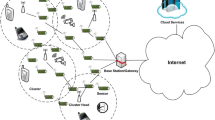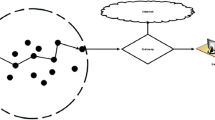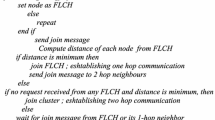Abstract
Compressive Sensing (CS) has proved to be a promising approach for the Internet of things (IoT) due to the fact that CS can abate the magnitude of raw data which is to be transmitted to the sink. It further helps in acquiring the traffic load balancing in the whole network. Recently, a plethora of research is reported that combines the clustering with CS in three genres; a plain CS, hybrid CS and a multi-path hybrid CS. However, the number transmissions are too high by the nodes (plain CS) or by the Cluster Heads (CHs) (hybrid or multi-path hybrid). While adopting the aforementioned genres of CS-based clustering, the selection of CH has not been given significant attention. This results in inevitable reduction the network lifetime of IoT-based WSN. Therefore, to extenuate the aforementioned concerns, in this paper, two contributions are reported. Firstly, the CH selection is done by the energy, distance, node density and average energy of the network that helps in the befitting CH selection of a node. Consequently, data gathering is improved and compression is done at the CH level. Secondly, the data reconstruction is also made better as compared to the state-of-the-art protocols helping in enhancing the Signal to Noise Ratio. The proposed scheme is named as Energy efficient CS based clustering framework (ECSCF). It is evident from the simulation that the ECSCF outperforms the competitive CS-based algorithms on the platform of different metrics namely, network lifetime, stability period, energy consumption, network’s remaining energy, etc.









Similar content being viewed by others
References
Shah, S. H., & Yaqoob, I. (2016). A survey: Internet of things (IOT) technologies, applications and challenges. In Smart energy grid engineering (SEGE), 2016 IEEE (pp. 381–385). IEEE.
Alaa, M., Zaidan, A. A., Zaidan, B. B., Talal, M., & Kiah, M. L. M. (2017). A review of smart home applications based on Internet of Things. Journal of Network and Computer Applications,97, 48–65.
Alaba, F. A., Othman, M., Hashem, I. A. T., & Alotaibi, F. (2017). Internet of things security: A survey. Journal of Network and Computer Applications,88, 10–28.
Aziz, A., Singh, K., Osamy, W., & Khedr, A. M. (2019). Effective algorithm for optimizing compressive sensing in IoT and periodic monitoring applications. Journal of Network and Computer Applications,126, 12–28.
Vieira, M. A. M., Coelho, C. N., Da Silva, D. C., & da Mata, J. M. (2003). Survey on wireless sensor network devices. In Emerging technologies and factory automation, 2003. Proceedings. ETFA’03. IEEE Conference (pp. 537–544). IEEE.
Rajagopalan, R., & Varshney, P. K. (2006). Data aggregation techniques in sensor networks: A survey. https://surface.syr.edu/eecs/22/.
Fasolo, E., Rossi, M., Widmer, J., & Zorzi, M. (2007). In-network aggregation techniques for wireless sensor networks: A survey. IEEE Wireless Communications,14(2), 70–87.
Eldar, Y. C., & Kutyniok, G. (2012). Compressed sensing: Theory and applications. Cambridge: Cambridge University Press.
Abbasi, A. A., & Younis, M. (2007). A survey on clustering algorithms for wireless sensor networks. Computer Communications,30, 2826–2841.
Deosarkar, B. P., Yadav, N. S., Yadav, R. P. (2008). Clusterhead selection in clustering algorithms for wireless sensor networks: A survey. In International conference on computing, communication and networking, 2008. ICCCn 2008 (pp. 1–8). IEEE.
Tanwar, S., Kumar, N., & Rodrigues, J. J. (2015). A systematic review on heterogeneous routing protocols for wireless sensor network. Journal of Network and Computer Applications,53, 39–56.
Hoult, D. I., & Richards, R. E. (1976). The signal-to-noise ratio of the nuclear magnetic resonance experiment. Journal of Magnetic Resonance,1969(24), 71–85.
Tyagi, S., & Kumar, N. (2013). A systematic review on clustering and routing techniques based upon LEACH protocol for wireless sensor networks. Journal of Network and Computer Applications,36, 623–645.
Smaragdakis, G., Matta, I., & Bestavros, A. (2004). SEP: A stable election protocol for clustered heterogeneous wireless sensor networks. Boston: Boston University Computer Science Department.
Qing, L., Zhu, Q., & Wang, M. (2006). Design of a distributed energy-efficient clustering algorithm for heterogeneous wireless sensor networks. Computer Communications,29(12), 2230–2237.
Kumar, D., Aseri, T. C., & Patel, R. B. (2009). EEHC: Energy efficient heterogeneous clustered scheme for wireless sensor networks. Computer Communications,32(4), 662–667.
Elbhiri, B., Saadane, R., Aboutajdine, D., et al. (2010). Developed distributed energy-efficient clustering (DDEEC) for heterogeneous wireless sensor networks. In 2010 5th international symposium on I/V communications and mobile network (ISVC) (pp. 1–4). IEEE.
Javaid, N., Qureshi, T. N., Khan, A. H., Iqbal, A., Akhtar, E., & Ishfaq, M. (2013). EDDEEC: Enhanced developed distributed energy-efficient clustering for heterogeneous wireless sensor networks. Procedia Computer Science,19, 914–919.
Qureshi, T. N., Javaid, N., Khan, A. H., Iqbal, A., Akhtar, E., & Ishfaq, M. (2013). BEENISH: Balanced energy efficient network integrated super heterogeneous protocol for wireless sensor networks. Procedia Computer Science,19, 920–925.
Kashaf, A., Javaid, N., Khan, Z. A., & Khan, I. A. (2012). TSEP: Threshold-sensitive stable election protocol for WSNs. In 2012 10th international conference on frontiers of information technology (FIT) (pp. 164–168). IEEE.
Mittal, N., & Singh, U. (2015). Distance-based residual energy-efficient stable election protocol for WSNs. Arabian Journal for Science and Engineering,40, 1637–1646.
Mittal, N., Singh, U., & Sohi, B. S. (2017). A stable energy efficient clustering protocol for wireless sensor networks. Wireless Networks,23, 1809–1821.
Naranjo, P. G. V., Shojafar, M., Mostafaei, H., Pooranian, Z., & Baccarelli, E. (2017). P-SEP: A prolong stable election routing algorithm for energy-limited heterogeneous fog-supported wireless sensor networks. The Journal of Supercomputing,73, 733–755.
Mittal, N., Singh, U., & Sohi, B. S. (2017). A novel energy efficient stable clustering approach for wireless sensor networks. Wireless Personal Communications,95, 2947–2971.
Sharma, D., Ojha, A., & Bhondekar, A. P. (2019). Heterogeneity consideration in wireless sensor networks routing algorithms: A review. The Journal of Supercomputing, 75, 2341–2394.
Guleria, K., & Verma, A. K. (2019). Comprehensive review for energy efficient hierarchical routing protocols on wireless sensor networks. Wireless Networks, 25, 1159–1183.
Baraniuk, R. G. (2007). Compressive sensing [lecture notes]. IEEE Signal Processing Magazine,24, 118–121.
Zhu, L., Zhang, W., Elnatan, D., & Huang, B. (2012). Faster STORM using compressed sensing. Nature Methods,9, 721.
Donoho, D. L. (2006). Compressed sensing. IEEE Transactions on Information Theory,52, 1289–1306.
Petrovic, D., Shah, R. C., Ramchandran, K., Rabaey, J. (2003). Data funneling: Routing with aggregation and compression for wireless sensor networks. In 2003 IEEE international workshop on sensor network protocols and applications, 2003. Proceedings of the first IEEE (pp. 156–162). IEEE.
Luo, C., Wu, F., Sun, J., & Chen, C. W. (2009). Compressive data gathering for large-scale wireless sensor networks. In Proceedings of the 15th annual international conference on mobile computing and networking (pp. 145–156). ACM.
Shen, Y., Hu, W., Rana, R., & Chou, C. T. (2013). Nonuniform compressive sensing for heterogeneous wireless sensor networks. IEEE Sensors Journal,13, 2120–2128.
Karakus, C., Gurbuz, A. C., & Tavli, B. (2013). Analysis of energy efficiency of compressive sensing in wireless sensor networks. IEEE Sensors Journal,13, 1999–2008.
Salim, A., & Osamy, W. (2015). Distributed multi chain compressive sensing based routing algorithm for wireless sensor networks. Wireless Networks,21, 1379–1390.
Nguyen, M. T., Teague, K. A., & Rahnavard, N. (2016). CCS: Energy-efficient data collection in clustered wireless sensor networks utilizing block-wise compressive sensing. Computer Networks,106, 171–185.
Abbasi-Daresari, S., & Abouei, J. (2016). Toward cluster-based weighted compressive data aggregation in wireless sensor networks. Ad Hoc Networks,36, 368–385.
Nguyen, M. T., & Teague, K. A. (2017). Compressive sensing based random walk routing in wireless sensor networks. Ad Hoc Networks,54, 99–110.
Qiao, J., & Zhang, X. (2018). Compressive data gathering based on even clustering for wireless sensor networks. IEEE Access,6, 24391–24410.
Tirani, S. P., & Avokh, A. (2018). On the performance of sink placement in WSNs considering energy-balanced compressive sensing-based data aggregation. Journal of Network and Computer Applications,107, 38–55.
Li, S., Da Xu, L., & Wang, X. (2013). Compressed sensing signal and data acquisition in wireless sensor networks and internet of things. IEEE Transactions on Industrial Informatics,9, 2177–2186.
Akkaya, K., & Younis, M. (2005). A survey on routing protocols for wireless sensor networks. Ad Hoc Networks,3, 325–349.
Shaobing, C., & Donoho, D. (1994). Basis pursuit. In 28th Asilomar conference on signals, systems computers.
Author information
Authors and Affiliations
Corresponding author
Additional information
Publisher's Note
Springer Nature remains neutral with regard to jurisdictional claims in published maps and institutional affiliations.
Rights and permissions
About this article
Cite this article
Manchanda, R., Sharma, K. Energy efficient compression sensing-based clustering framework for IoT-based heterogeneous WSN. Telecommun Syst 74, 311–330 (2020). https://doi.org/10.1007/s11235-020-00652-2
Published:
Issue Date:
DOI: https://doi.org/10.1007/s11235-020-00652-2




